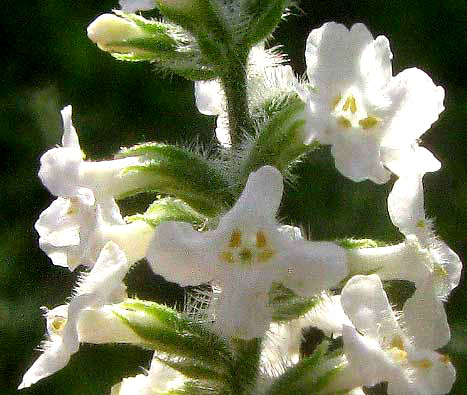Excerpts from Jim Conrad's
Naturalist Newsletter
from the June 30, 2013 Newsletter issued from the Frio Canyon Nature Education Center in the valley of the Dry Frio River in northern Uvalde County, southwestern Texas, on the southern border of the Edwards Plateau; elevation ~1750m (~5750 ft); N29.62°, W99.86°; USA
WHITEBRUSH FLOWERING
On our visit to Dave's ranch ten miles south of us we descended in elevation from our position on the Edwards Plateau's southern slope so slowly that it wasn't noticeable, except in terms of vegetation change. Along the road as we traveled, more and more species appeared typical of the deserty, acacia-rich scrub forest farther south and west of us. In a prairie patch at the entrance to Dave's ranch a plant I've not seen at our higher elevation appeared, as shown below:
 .
.
It was so late in the afternoon that the setting sun's rays exploded within the eight-ft-tall (2.4m) bush's white flower-spikes. Wind violently shook the flowers, spectacularly showing them off against their dark backgrounds. The bush seemed to be motioning to be noticed. As I drew near, before I could see any detail of flower or leaf the bush's fragrance, dizzying and vanilla-like, engulfed me. Who would have thought that such a wild, diffusely growing bush might smell so good, and what plant could this be? Up close, the flowers' shapes provided a big hint, as you can see below:

The blossoms with their curved corolla tubes and asymmetrical faces look much like flowers of verbena and lantana, which are members of the big Verbena Family, the Verbenaceae, so now I knew into which family to look once I began "doing the botany."
The fragrant, gesticulating bush revealed itself as ALOYSIA GRATISSIMA, among whose common names are Whitebrush, Beebrush, Jazminillo (Little Jasmine), Hierba de la Princesa (Princess Plant) and Chaparro Blanco. Whitebrush occurs in arid parts of the southwestern US and most of Mexico, plus there's another population occupying a large part of southern South America.
While to me Whitebrush is extremely attractive, ranchers lower down regard it an aggressive weed of rangeland that forms thickets, especially on disturbed ground. The thickets provide wonderful protective cover for wildlife, but when horses eat Whitebrush's herbage they develop a rickets-like disease.
Still, Whitebrush strikes me as an outstanding candidate for being grown in lawns in arid areas. Throughout the year it flowers prolifically after rains, and survives extended droughts and very high temperatures.
And surely no fragrance could be more delightful than that very generously produced by this plant.